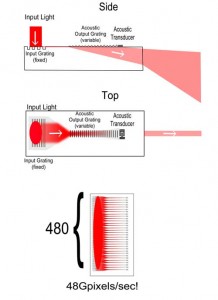Light Modulators for Holographic Video Displays
- Category: Electronic Devices, Optics & Photonics
- Tags: v. michael bove jr.
In this research we seek to develop acousto-optic, guided-wave modulators in proton-exchanged lithium niobate[1] for use in holographic and other high-bandwidth displays. Guided-wave techniques make possible the fabrication of modulators that are higher in bandwidth and lower in cost than analogous bulk-wave acousto-optic devices and have the potential for simultaneous modulation of red, green, and blue light[2][3][4]. In particular, we are investigating multichannel variants of these devices with an emphasis on maximizing the number of modulating channels to achieve large total bandwidths. Efficient, low-cost, monolithic modulators capable of modulating billions of pixels/sec should be possible. Figures 1 and 2 show one of our full-color devices and a schematic diagram of it.
- Figure 1: A full-color device undergoing testing.
- Figure 2: Diagram of our device.
- C. S. Tsai, Q. Li, and C. L. Chang, “Guided-wave two-dimensional acousto-optic scanner using proton-exchanged lithium niobate waveguide,” Fiber and Integrated Optics, vol. 17, pp. 57-166, 1998. [↩]
- D. E. Smalley, Q. Y. J. Smithwick, V. M. Bove, Jr., J. Barabas, and S. Jolly, “Anisotropic leaky-mode modulator for holographic video displays,” Nature, vol. 498, pp. 313-317, doi:10.1038/nature12217, 2013.. [↩]
- D. Smalley, Q. Smithwick, J. Barabas, V. M. Bove, Jr., S. Jolly, and C. Della Silva, “Holovideo for everyone: a low-cost holovideo monitor,” J. Phys.: Conf. Ser. 15 012055 http://dx.doi.org/10.1088/1742-6596/415/1/012055, 2013. [↩]
- J. Barabas, S. Jolly, D. E. Smalley, and V. M. Bove, Jr., “Diffraction specific coherent panoramagrams of real scenes,” in Proc. SPIE Practical Holography XXV, vol. 7957, p. 795702, 2011. [↩]

